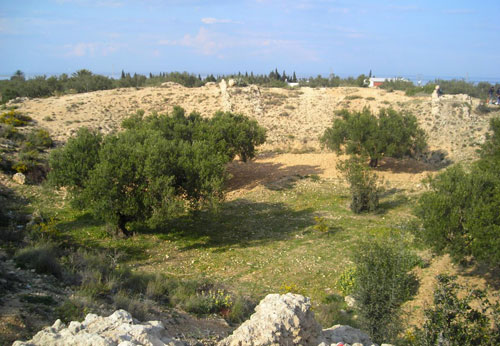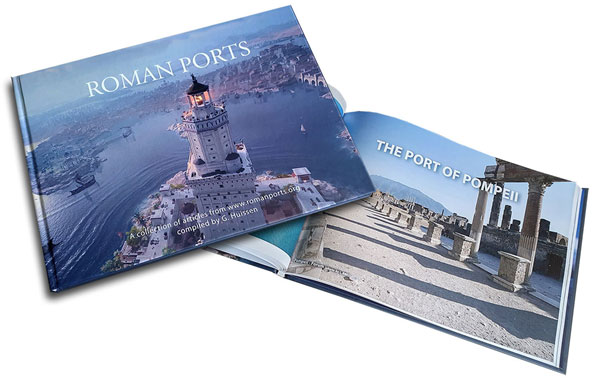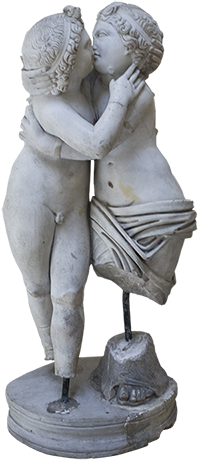2
Introduction
Mosaic in front of tomb 43.
"This is a place free of fear!"
This Greek text was placed in front of the entrance of one of the tombs on the ancient Roman burial place. The text forms part of a mosaic on which we can see two sailing vessels entering the harbour of Portus. For the "inhabitants" of this necropolis, the text had a double meaning. The vessels were brought into a place outside the reach of the dangerous sea and, similarly, the deceased had, by taking his last boat trip over the river Styx1 , changed his worldly vale of tears into the eternal peace of the underworld. For me, as the author of this section of the website, there is a third sense.
Floor mosaic at the necropolis entrance. As so many others I'm very interested in people, their behaviour, thoughts and feelings. People not as a group, but as individuals. Each person feels himself standing in the centre of his own existence. For him or her everything is related to his own ego. Questions like 'who am I', 'where do I come from' and 'where am I going to' are quickly put. Questions which are not easy to answer and often give you a certain fear for the unknown. We have to realise, however, that in this we are not standing alone. Many have proceeded us and many will follow. 2 . I was immediately impressed by this spot. After reading some articles and especially the book of the British historican, Russel Meiggs, "Roman Ostia", I understood that I had to do with an ancient city that rose and fell into decay together with Rome. A city populated by ordinary people like you and me. A city where, walking through the now deserted streets, you might expect an ancient inhabitant coming out of a door or sitting on a public toilet.
The ‘Isola Sacra’ quarter in Fiumicino. Nowadays we can still find the name Isola Sacra (Sacred Island) on traffic signs in the neighbourhood of the airport of Rome. Here we have to do with a district of the present city Fiumicino, a coastal town on the west side of Rome. Only a few Italians can explain you why that particular part of Fiumicino has that name and even less people are able to give you any information about the origin of the name. We have to admit, for an island you have to look twice and any trace of sacredness is far away. Even the ancient Romans would be surprised when hearing this name.
The island between Ostia and Portus formed by the Tiber, the Fossa Traiana and the sea. As far as we know, even the ancient Romans didn't use the name Isola Sacra. In the fifth century AD an ancient writer, called Aethicus of Istria, mentioned in his "Cosmographia" the place as "Libanus Almae Veneris"3 . In 536 Procopius used the name Isola Sacra for the first time in his "De bello gothico" 4 . Why he called the piece of land 'Isola Sacra' is not quite clear. One of the reasons could be the presence of the basilica of St. Hippolytus, an early Christian martyr from Portus. This basilica was built at the end of the fourth and the beginning of the fifth century, perhaps on the remains of a Roman temple dedicated to Isis. In the sixties of the 20th century during excavations on this location there has been found a statue of this goddess.
The extended part of the Fossa Traiana in Fiumicino, called the Fiumara Piccola. At the beginning of the first century AD there was already a road between Ostia and Portus, the Via Flavia, later called the Via Severiana. On the south side you could reach Ostia probably via a ferry, and on the north side there was a bridge over the Fossa Traiana, the 'Pons Matidiae' to enter Portus. Not long after the construction of the new harbour, the people of Portus started to bury their dead along this road. According to the Roman law this had to be done outside the city. This part of the website will give you an impression of this unique necropolis. Of the original road, approximately 1300 feet has been preserved, including the part along the necropolis. Research has shown that the Via Severiana had a width of 35 feet and was divided into two separate lanes. The borders of the road were formed by a 3,65 feet thick wall. Each 10 feet there was a buttress to support the wall.
The Via Severiana at the necropolis looking towards Ostia. The rediscovery of the necropolis
Part of portrait of Emmanuel Théodose 5 The French cardinal was sent to Rome as an ambassador, became Dean of the Sacred College, and consequently Bishop of Ostia between 1700 and 1715. We know that he excavated a big tomb belonging to the family Caesennii. Several inscriptions have been found and published on his behalf. Unfortunately the originals are lost today and the location of this tomb is unknown. According to the publications it measured circa 88,8 x 28,4 m. A tomb of that size is nowadays unknown on the necropolis of Isola Sacra.6 . In this section of the website we will also describe these graves, as far as possible. Because these graves are located close to the Trajan's Canal, we refer to them as the Canal tombs to distinguish them from the large necropolis. The graves are located along the road that runs from Isola Sacra to the centre of Fiumicino. You're not allowed to enter this site but you can see the tombs from the road.
Excavations of the Isola Sacra necropolis in 1938 (Photo's Soprintendenza Ostia Antica). The cemetery we see today wasn't the only Roman cultivation on the artificial island. Excavations by Fausto Zevi in the sixties of the last century brought to light the remains of buildings on the Ostia as well as on the Portus side7 . These buildings served mainly harbour activities.
No tombs of rich people or men of standing have been found in the necropolis. The tombs we know today were meant for the local middle class, their servants, slaves and freedmen. With the exception of a single sarcophagus, we don't find traces of Judaism or Christianity. Also tombs of followers of other foreign religions are lacking. Almost all 'inhabitants' of this necropolis were Roman citizens and believers of the official Roman religion.
Sources Russel Meiggs - Roman Ostia, At the Clarendon Press 1973
Guido Calza - Necropoli nell'Isola Sacra'(1940)
Dr. Jan Theo Bakker.
1: De Styx was de mythologisch rivier waarover de overledene, na betaling van een muntstuk dat aan de dode werd meegegeven in zijn graf, door de veerman Charon naar de onderwereld (Hades) werd gevaren.
2: Read our article Alberino Vicari "Il Biondo" .3: The paradise of Venus4: Four books written by the Greek historican from Caesarea Maritima, Procopius, in which he described the Italian campaigns by Belisarius and others against the Ostrogoths.5: Le cardinal de Bouillon painted by Hyacinthe Rigaud (1659–1743), 1707, musée Hyacinthe-Rigaud, Perpignan.6: See our article 'Eventually, it's all about people' .7: For more information about other classical buildings at the Isola Sacra, see https://www.ostia-antica.org/isola/text-menu.htm
3
Ostia
"The river widens considerably as it reaches the sea and forms large bays, like the best sea harbours. And, most surprising of all, it is not cut off from its mouth by a barrier of sea sand, which is the fate even of many large rivers."
"Ships with oars, however large, and merchantmen with sails up to 3,000 (amphorae) capacity enter the mouth itself and row or are towed up to Rome; but larger ships ride at anchor outside the mouth and unload and reload with the help of river vessels." 1
At the end of the first century BC Dionysius of Halicarnassus described the mouth of the river Tiber. For Rome the river had been the most important overseas supply route for goods, especially grain. 2 , fourth king of Rome, decided that it was time to bring the road between Rome and Ostia under the jurisdiction of Rome. Round about 620 BC he reorganized the salt making and founded the first Roman colony in the angle between the mouth of the Tiber and the sea. He called that first dwelling after the Latin word for "mouth", Ostia.
Memorial table originally attached above the eastern citygate, the Porta Romana.
Mosaic with a Roman trading ship 3 , shops were opened and the local middle class increased explosively. At the height of its prosperity, in the second century AD, about 40,000 people were housed in Ostia. The city developed then as a real city with its own temples, bathhouses, a theatre, shops, warehouses, construction places, workshops, guilds and so on. 4 , a four-storied lighthouse was placed. Round about 110 AD the emperor Traianus enlarged the new harbour with a large landlocked inner hexagonal basin. The harbours were connected with the Tiber by channels.The remains of the northern pier of the harbour basin of Claudius. In the background, the buildings of Fiumicino Airport, Leonardo Davinci.
Sources Russel Meigs - Roman Ostia, At the Clarendon Press 1973
Guido Calza - Necropoli nell'Isola Sacra'(1940)
Dr. Jan Theo Bakker.
1: Dionysius of Halicarnassus was a Roman historian, rhetoric and writer. He was born in Turkey in 60 BC and died in Rome in 7 BC. Writer(in Greek) of 'Roman Antiquities'2: Ancus Martius ruled 24 years from 640 till 616 BC3: Read the article 'Overseas Trade' 4: In 37 AD Caligula transported an obelisk from Alexandria to Rome, via Ostia and the Tiber. It was to be erected on the spina of the Vatican Circus. The ship used for this was subsequently sunk between the piers of Portus, Claudius' new harbour, and used as the foundation for the lighthouse.
4
Tomb types
This part of the website will inform you about the kind of burials and about the architecture of the funeral buildings in the necropolis of Isola Sacra.
When Portus was built in the middle of the first century AD, the dead were always cremated in so called public ustrina1 . This custom continued till the reign of the emperor Hadrian (117 AD), when burial was introduced and for a long time cremation and inhumation went side by side.
Tomb of Priscilla at the Appia Antica in Rome2
Amphorae as final resting place in a grave on the east side of the cemetery. Simply burials on the 'Field of the poor' on the Isola Sacra.
Many of the simplest graves have been found in the area called "Field of the poor" or, as the Italians call it, 'Campo dei poveri'. The field is located behind tombs 38 - 43. During the excavations of 1988-89, 650 small graves were found. Most of these graves are covered again and can't be seen anymore. You will notice, however, another type of tomb in the Campo dei poveri, the so called 'tomba a cassone'. This tomb has the shape of, as the Italian name says, a big chest. Sometimes the owner tried to imitate the larger and more expensive monumental tombs by adding an aedicula3 , a tympanum4 or even a fake door. The "tomba a cassone" is not found just in the "Campo dei poveri". You can find them also in other parts of the necropolis.
Tomb 52 (foreground) and tomb 53. The "tomba a cassone" was well known along the entire coast of the Mediterranean. In Rome, however, this type of grave was hardly used. In Portus we find a concentration of these tombs. It probably tells something about the cosmopolitan character of the population of Portus.
The libation gap in the top of a "tomba a cassone" (tomb 62). 5 purposes. From left to right: tomb 1, 51 and 56. The majority of the tombs in this necropolis are 'tombe a cella'. This means a tomb with one or more burial chambers. They were detached or part of a row. 6 . Inside, they all had a fixed design, with the exception of tomb 75, built for three families, and tomb 34, probably belonging to a collegium funeraticium , a funeral association.
"Small bricks, regular and manufactured with care, selected on size and colour; An entrance consisting of two jambs with an architrave of travertine; Brick columns with capitals, made of several materials, on top; A marble slab with inscription, surrounded by a frame, above the entrance; Two small windows in one line with the inscription; A relief depicting the profession of the tomb owner; A tympanum in the top part. This was not always the case, but many of the tombs with burial chambers contained several of these elements".
There are still some examples of façades built in a combination of brick and tufa (opus reticulatum ), but often reticulate was only used for the back and side-walls. columbaria . The urns with the ashes of the dead were placed in semicircular or rectangular niches in the walls. Normally each niche contained two urns. These niches were built alongside a larger and better decorated central niche.
Because most of the tombs were used for a long time, after a while all the niches were filled. New space was often found by adding an enclosure to the front. The walls of these enclosures too were occupied by niches.
Biclinium in front of tomb 15 biclinia , were built on either side of the entrance. biclinia had to make way to new tombs. arcosolia7 . Later on, small niches were replaced by arcosolia and in new tombs the number of arcosolia increased. Tomb with arcosolia in the walls and formae in the floor. arcosolia are uneconomic in space, soon the area underneath the floor was also used. The floor was divided by brick walls into a series of graves, called formae , sometimes one row on top of another. arcosolia or formae without a sarcophagus. The arcosolium itself was closed by a rough wall, sometimes plastered, imitating marble, or by a marble slab. The latter are plain or decorated. Formae were often covered by the mosaic or marble floor of the burial chamber. arcosolia . Supports were built against the walls to carry sarcophagi. Marble was reused.
Sources Russel Meigs - Roman Ostia, At the Clarendon Press 1973
Guido Calza - Necropoli nell'Isola Sacra'(1940)
Dr. Jan Theo Bakker.
Ida Baldassare, Irene Bragantini, Chiara Morselli and Franc Taglietti - Necropoli di Porto, Isola Sacra (Roma 1996).
1: An ustrinum (plural ustrina) was the site of a cremation funeral pyre whose ashes were removed for interment elsewhere (Wikipedia).2: Photo Notafly (Wikipedia)3: A small shrine4: A semi-circular or triangular decorative wall surface over an entrance, door or window.5: Libation was a religious act in the form of a liquid offering, most often unmixed wine and perfumed oil (Scheid 2007, p. 269).6: A Roman foot (pes, plural: pedes) measures 296 mm.7: Arcosolium (plural arcodolia): from Latin arcus, 'arch', and solium, 'throne' (literally 'place of state')






 We are committed to providing versions of our articles and interviews in several languages, but our first language is English.
We are committed to providing versions of our articles and interviews in several languages, but our first language is English.